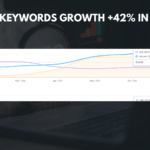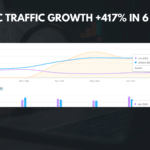
Website analytics is a powerful tool that allows website owners to gain valuable insights into their website’s performance. By analyzing data such as traffic sources, user behavior, and conversion rates, website analytics can help businesses make informed decisions to improve their online presence and drive more conversions. In today’s digital age, where competition is fierce and user expectations are high, understanding and utilizing website analytics is crucial for success.
Key Takeaways
- Website analytics is the process of collecting and analyzing data about website usage and performance.
- Setting up analytics tools correctly is crucial for accurate data collection and analysis.
- Metrics such as pageviews, bounce rate, and conversion rate are important for understanding website traffic and user behavior.
- Identifying and targeting high-value website visitors can lead to increased conversions and revenue.
- Optimizing website design and user experience can improve engagement and retention.
Understanding the Basics of Website Analytics
Website analytics refers to the collection, measurement, analysis, and reporting of data related to website usage. It provides valuable information about how users interact with a website, including where they come from, what pages they visit, how long they stay on the site, and whether or not they convert into customers. This data is collected through various tools and platforms, such as Google Analytics, which is one of the most popular website analytics tools available.
There are different types of website analytics that can be used to measure different aspects of a website’s performance. Some common types include:
– Traffic analytics: This type of analytics focuses on measuring the volume and quality of traffic coming to a website. It provides insights into where the traffic is coming from (e.g., search engines, social media, referrals), which pages are attracting the most visitors, and how users are navigating through the site.
– Conversion analytics: Conversion analytics focuses on measuring the effectiveness of a website in converting visitors into customers or achieving other desired actions (e.g., signing up for a newsletter, downloading a whitepaper). It helps businesses understand which pages or elements of their website are driving conversions and identify areas for improvement.
– User behavior analytics: User behavior analytics tracks how users interact with a website, including their click patterns, scrolling behavior, and time spent on each page. This data can provide insights into user preferences and help businesses optimize their website for better user experience.
Setting Up Your Analytics Tools for Success
Choosing the right analytics tool is crucial for setting up your website analytics for success. There are many analytics tools available, but one of the most popular and widely used is Google Analytics. It offers a comprehensive set of features and is free to use for most businesses.
To set up Google Analytics, you will need to create an account and add a tracking code to your website. The tracking code is a small snippet of code that needs to be added to every page of your website. Once the tracking code is in place, Google Analytics will start collecting data about your website’s performance.
In addition to setting up Google Analytics, it is also important to integrate your analytics tool with your website. This can be done by adding tracking codes to specific elements of your website, such as buttons or forms, to track specific actions or events. Integration allows you to track and analyze the effectiveness of different elements of your website in driving conversions.
Analyzing Your Website Traffic: Metrics That Matter
| Metrics | Description |
|---|---|
| Visits | The number of times your website has been visited. |
| Unique Visitors | The number of individual people who have visited your website. |
| Pageviews | The number of pages viewed on your website. |
| Average Time on Site | The average amount of time visitors spend on your website. |
| Bounce Rate | The percentage of visitors who leave your website after viewing only one page. |
| Conversion Rate | The percentage of visitors who complete a desired action on your website, such as making a purchase or filling out a form. |
| Referral Traffic | The number of visitors who come to your website from another website. |
| Organic Traffic | The number of visitors who come to your website from search engines. |
| Social Media Traffic | The number of visitors who come to your website from social media platforms. |
Analyzing your website traffic is an essential part of website analytics. It helps you understand where your traffic is coming from, how users are finding your website, and which sources are driving the most conversions. By analyzing these metrics, you can make informed decisions about where to focus your marketing efforts and optimize your website for better performance.
One important metric to analyze is traffic sources. This metric tells you where your traffic is coming from, whether it’s from search engines, social media platforms, referrals from other websites, or direct traffic. By understanding which sources are driving the most traffic, you can allocate resources accordingly and optimize your marketing efforts.
Another important metric to analyze is bounce rate. Bounce rate refers to the percentage of visitors who leave your website after viewing only one page. A high bounce rate can indicate that users are not finding what they are looking for or that there are issues with your website’s design or navigation. By analyzing bounce rate, you can identify areas for improvement and make changes to reduce bounce rate and increase user engagement.
Time on site is another metric that provides insights into user behavior. It measures the average amount of time users spend on your website. A high average time on site can indicate that users are finding your content valuable and engaging, while a low average time on site may suggest that users are not finding what they are looking for or that your content is not engaging enough. By analyzing this metric, you can identify areas where you can improve user engagement and increase the time users spend on your website.
Pages per session is another important metric to analyze. It measures the average number of pages users visit during a single session on your website. A high average pages per session indicates that users are exploring multiple pages of your website, which can lead to increased engagement and higher chances of conversion. By analyzing this metric, you can identify which pages are driving the most engagement and optimize your website’s navigation to encourage users to visit more pages.
Conversion rate is perhaps the most important metric to analyze when it comes to website analytics. It measures the percentage of visitors who complete a desired action, such as making a purchase or filling out a form. By analyzing conversion rate, you can identify which pages or elements of your website are driving conversions and make changes to optimize your conversion funnel.
Identifying Your Most Valuable Website Visitors
Understanding who your target audience is and how they behave on your website is crucial for optimizing your website’s performance. By analyzing demographics and behavior data, you can identify your most valuable website visitors and tailor your marketing efforts to attract more of them.
Defining your target audience involves identifying the characteristics of the people who are most likely to be interested in your products or services. This includes factors such as age, gender, location, interests, and purchasing behavior. By understanding who your target audience is, you can create targeted marketing campaigns that resonate with them and drive more qualified traffic to your website.
Analyzing demographics and behavior data can provide valuable insights into your target audience’s preferences and behavior. For example, you can analyze data such as the average age and gender of your website visitors, the devices they use to access your website, and the pages they spend the most time on. This information can help you tailor your website’s design, content, and user experience to better meet the needs and preferences of your target audience.
Identifying high-value visitors is another important aspect of website analytics. High-value visitors are those who are most likely to convert into customers or take other desired actions on your website. By analyzing data such as conversion rate, average order value, and lifetime value, you can identify which segments of your audience are the most valuable and focus your marketing efforts on attracting more of them.
Optimizing Your Website for Better User Experience

User experience plays a crucial role in the success of a website. A positive user experience can lead to increased engagement, higher conversion rates, and improved customer satisfaction. By analyzing user behavior data, you can identify areas where your website can be optimized for better user experience.
Analyzing user behavior involves tracking how users interact with your website, including their click patterns, scrolling behavior, and time spent on each page. This data can provide insights into how users navigate through your website, which pages they find most engaging, and where they may be encountering issues or obstacles.
Improving website design and navigation is one way to optimize user experience. By analyzing user behavior data, you can identify areas where users may be getting stuck or experiencing difficulties. For example, if you notice that users are spending a lot of time on a particular page without taking any action, it may indicate that there is a problem with the design or layout of that page. By making changes to improve the design or navigation of your website, you can create a more intuitive and user-friendly experience.
Measuring Your Website’s Conversion Rate
Conversion rate is a key metric to measure when it comes to website analytics. It measures the percentage of visitors who complete a desired action, such as making a purchase or filling out a form. By analyzing conversion rate data, you can identify areas where your website’s conversion funnel can be optimized and make changes to improve your conversion rate.
Conversion rate is calculated by dividing the number of conversions by the number of visitors and multiplying by 100. For example, if you had 1000 visitors to your website and 100 of them made a purchase, your conversion rate would be 10%.
There are different types of conversions that can be measured, depending on the goals of your website. Some common types of conversions include:
– E-commerce conversions: These are conversions that involve a purchase on an e-commerce website. They can be measured by tracking the number of completed transactions and the total revenue generated.
– Lead generation conversions: These are conversions that involve capturing leads, such as filling out a contact form or signing up for a newsletter. They can be measured by tracking the number of leads generated and the conversion rate.
– Micro-conversions: These are smaller actions that users take on your website that may not directly lead to a sale or lead, but are still valuable indicators of engagement. Examples include downloading a whitepaper, watching a video, or adding items to a wishlist. Micro-conversions can be measured by tracking the number of actions taken and the conversion rate.
Analyzing conversion data involves looking at metrics such as conversion rate, average order value, and lifetime value. By analyzing these metrics, you can identify areas where your website’s conversion funnel can be optimized and make changes to improve your conversion rate.
Tracking Your Marketing Campaigns with Website Analytics
Tracking your marketing campaigns is crucial for understanding their effectiveness and optimizing your marketing efforts. By using website analytics, you can track and analyze data related to your marketing campaigns to gain insights into which campaigns are driving the most traffic, conversions, and revenue.
Tracking marketing campaigns involves setting up campaign tracking parameters in your analytics tool. This can be done by adding specific tags or parameters to the URLs of your campaign landing pages. For example, you can add a parameter to track traffic from a specific email campaign or social media post.
By setting up campaign tracking, you can track and analyze data such as the number of visitors, conversions, and revenue generated from each campaign. This data can help you understand which campaigns are driving the most results and make informed decisions about where to allocate your marketing budget.
Analyzing campaign data involves looking at metrics such as traffic sources, conversion rate, and return on investment (ROI). By analyzing these metrics, you can identify which campaigns are the most effective and make changes to optimize your marketing efforts.
Analyzing Your Competitors’ Websites with Analytics
Analyzing your competitors’ websites can provide valuable insights into their strategies and help you identify areas where you can improve your own website’s performance. By using website analytics, you can track and analyze data related to your competitors’ websites to gain insights into their traffic sources, user behavior, and conversion rates.
Analyzing competitors’ websites involves identifying who your competitors are and tracking their website performance using tools such as Google Analytics or similar analytics platforms. By analyzing data such as traffic sources, bounce rate, time on site, and conversion rate, you can gain insights into how your competitors are attracting and engaging visitors.
Identifying competitors can be done by conducting market research and analyzing industry trends. Look for businesses that offer similar products or services to yours and target the same audience. Once you have identified your competitors, you can start tracking their website performance using analytics tools.
Analyzing competitors’ traffic and behavior data can provide insights into their marketing strategies and user engagement tactics. For example, if you notice that a competitor is getting a significant amount of traffic from social media platforms, it may indicate that they have a strong social media marketing strategy. By analyzing this data, you can identify areas where you can improve your own marketing efforts and gain a competitive advantage.
Leveraging Website Analytics for Better SEO
Search engine optimization (SEO) is crucial for driving organic traffic to your website. By using website analytics, you can track and analyze data related to your search engine traffic to gain insights into how users are finding your website and optimize your SEO strategy.
Analyzing search engine traffic involves looking at metrics such as organic search traffic, keyword rankings, and click-through rates (CTRs). By analyzing these metrics, you can identify which keywords are driving the most traffic to your website and make changes to optimize your SEO strategy.
For example, if you notice that a particular keyword is driving a significant amount of traffic to your website, you can create more content around that keyword or optimize existing content to rank higher in search engine results. By analyzing search engine traffic data, you can identify opportunities to improve your website’s visibility in search engines and attract more organic traffic.
Improving SEO with analytics data also involves analyzing user behavior data. By tracking how users interact with your website after coming from a search engine, you can gain insights into their preferences and behavior. For example, if you notice that users are spending a lot of time on a particular page after coming from a search engine, it may indicate that the page is providing valuable information related to their search query. By optimizing this page with relevant keywords and improving its content, you can increase its visibility in search engine results and attract more organic traffic.
Using Analytics to Improve Your Website’s Content Strategy
Content strategy plays a crucial role in attracting and engaging visitors on your website. By using website analytics, you can track and analyze data related to your content performance to gain insights into which content is driving the most traffic, engagement, and conversions.
Analyzing content performance involves looking at metrics such as page views, time on page, and conversion rate for each piece of content on your website. By analyzing these metrics, you can identify which pieces of content are the most popular and make informed decisions about where to focus your content creation efforts.
For example, if you notice that a particular blog post is driving a significant amount of traffic and engagement, you can create more content around similar topics or optimize existing content to provide more value to your audience. By analyzing content performance data, you can identify opportunities to improve your content strategy and attract more visitors to your website.
Improving content strategy with analytics data also involves analyzing user behavior data. By tracking how users interact with your content, such as their click patterns and time spent on each page, you can gain insights into their preferences and behavior. For example, if you notice that users are spending a lot of time on a particular page or scrolling through a long-form blog post, it may indicate that they find the content valuable and engaging. By creating more content that meets their needs and preferences, you can increase engagement and drive more conversions.
In conclusion, website analytics is a powerful tool that can provide valuable insights into your website’s performance. By analyzing data related to traffic sources, user behavior, conversion rates, and more, you can make informed decisions to optimize your website for better performance and drive more conversions.
Setting up your analytics tools is an essential step in understanding and optimizing your website or app’s performance. There are several key components to consider when setting up analytics tools. First, you need to choose the right tool for your needs, such as Google Analytics, Adobe Analytics, or Mixpanel. Once you have selected a tool, you will need to install the tracking code on your website or app. This code allows the tool to collect data on user behavior, such as page views, clicks, and conversions. Additionally, you will need to set up goals and events within the analytics tool to track specific actions or behaviors that are important to your business. Finally, it is crucial to regularly review and analyze the data collected by your analytics tool to gain insights and make data-driven decisions for improving your website or app’s performance.
If you’re interested in unlocking the secrets of search engine optimization in India, Media Officers has a comprehensive guide that can help. This article provides valuable insights and strategies to improve your website’s visibility and drive organic traffic. Check out their guide here and take your website analytics to the next level.
FAQs
What are website analytics?
Website analytics refer to the collection, measurement, and analysis of data related to website usage and performance. This data can include information about website traffic, user behavior, and conversion rates.
Why are website analytics important?
Website analytics are important because they provide valuable insights into how users interact with a website. This information can be used to optimize website performance, improve user experience, and increase conversions.
What types of data can be collected through website analytics?
Website analytics can collect a wide range of data, including website traffic, user demographics, user behavior, conversion rates, and more. This data can be used to gain insights into how users interact with a website and identify areas for improvement.
What tools are used for website analytics?
There are many tools available for website analytics, including Google Analytics, Adobe Analytics, and Piwik. These tools use various methods to collect and analyze website data, such as tracking code, cookies, and log files.
How can website analytics be used to improve website performance?
Website analytics can be used to identify areas for improvement on a website, such as pages with high bounce rates or low conversion rates. This information can be used to optimize website content, improve user experience, and increase conversions. Additionally, website analytics can be used to track the success of marketing campaigns and make data-driven decisions about future campaigns.























































